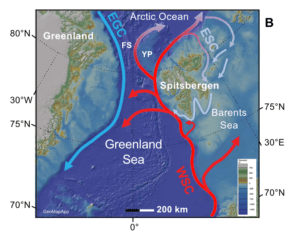
Eastern Fram Strait Paleo-Archive


Sitting between Greenland and Svalbard is a deep-water passage that connects the Arctic Ocean with the Northern Atlantic to the south. Today this passage is best defined by the presence of a warm northward flowing current west of Spitsbergen (WSC) and the cool southward flowing East Greenland Current (EGC).By looking at the northward flowing current, which moves heat, salt, and moisture into the Arctic region, Expedition 403: “Eastern Fram Strait Paleo-Archive” will collect crucial data to ground-truth climate mod-els of projected future CO2, temperature, ocean circulation, sea ice, and present Earth ice sheet stability.
Led by Renata Giulia Lucchi (National Institute of Oceanography and Applied Geophysics-OGS) and Kristen St. John (James Madison University), Expedition 403 will depart from the port of Amsterdam in early June. Making the voyage northward, the researchers plan to drill at six primary sites along the western shore of Svalbard’s largest land mass. At the deepest point, the expedition aims to retrieve samples from 738 meters below the seafloor.

Primary Objectives
- The reconstruction of the West Spitsbergen Current (WSC) & North Atlantic Water (NAW) variability
- The influence these water patterns have on climate changes particularly during key climate transitions (late Miocene–Pliocene transition, late Pliocene–Pleistocene transition, MPT, mid-Brunhes transition, and suborbital Heinrich-like events
- Impact this exchange has on the Arctic glaciations, ice shelves development and stability, and sea ice distribution.
Background
Over millions of years, sediment has collected under the influence of marine biological activity, advancing and retreating glaciers on the continental margin, and the warm current moving along the seafloor in the eastern Fram Strait. These sediment drifts hold clues of key climate transitions, useful climate proxies, and insights into the onset of the Northern Hemisphere glaciation (NHG). Through a more detailed reconstruction of the WSC and NAW, researchers will be better able to inform the climate models that guide our future in a warming world.
While the Arctic and North Atlantic Oceans play a significant role in the climactic evolution of the Northern Hemisphere, the findings of this expedition also shine a light on the future of the Southern Pole. One of the influences of the depositional history being sampled is the onshore geology, including the dynamics of the Svalbard-Barents Sea Ice Sheet (SBSIS) complex. The Paleo marine-based SBSIS is considered the best analog for the modern West Antarctic Ice Sheet (WAIC). Easier to access than the Antarctic ice sheet, the paleo SBSIS record becomes an ideal laboratory to explore the effects of ice-atmosphere-ocean interactions under fast, warm climatic oscillations. With an increasingly warming climate, the loss of stability of the WAIC is a significant concern for future global projections of sea level rise.
Historical Significance
Expedition 403 stands out in significance not only because it will return with data to better understand some of the most pressing details of our changing climate, but also for its historic role as the last expedition of the JOIDES Resolution within the International Ocean Discovery Program. While the future of the veteran ship is still uncertain, the likeliest outcome is that the decommissioning process will begin in the port of Amsterdam soon after the conclusion of this expedition.

Outreach
Tim Lyons, Chris Lyons, and Khyber Jones are boarding the JR to film a documentary and serve as our outreach officers. Follow along as they document Expedition 403 as well as the expansive history of the JOIDES Resolution as a celebration of the end of it’s Scientific Ocean Drilling Career! You can find regular updates on the JR social media accounts, including Twitter, Facebook, and Instagram, and learn about our progress in the Ship Reports and Friends & Family Photo Gallery.
